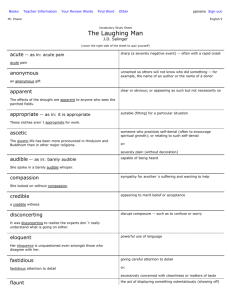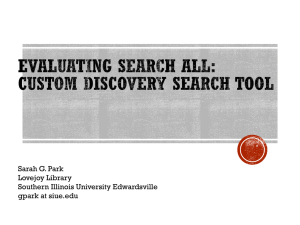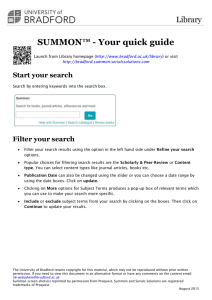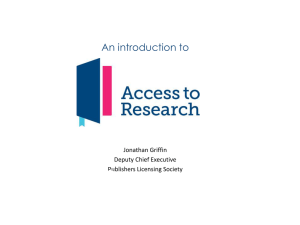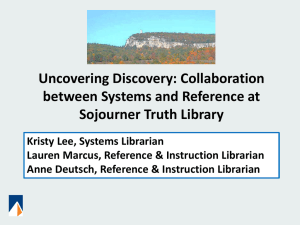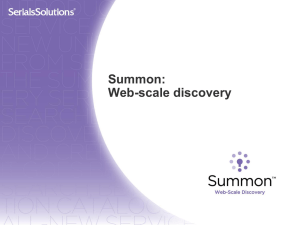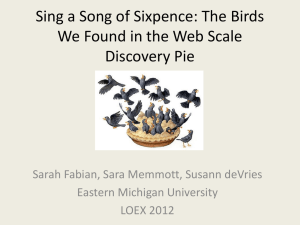File - Stephanie Freas
advertisement
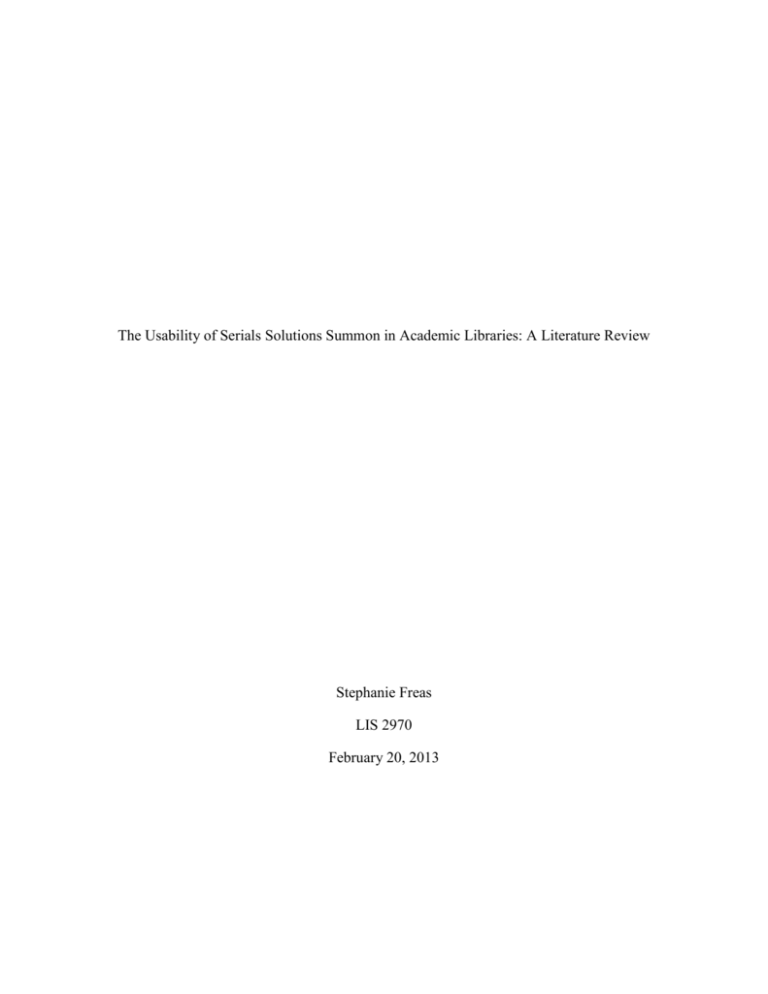
The Usability of Serials Solutions Summon in Academic Libraries: A Literature Review Stephanie Freas LIS 2970 February 20, 2013 1 Web-scale delivery tools are defined by Julie Gross and Lutie Sheridan (2011) as a way of “combining access to both library catalogue and journal database content in one search tool” (237). These discovery tools, such as Serials Solutions Summon, imitate the search experiences created by search engines like Google to provide users with easy searching and extensive, yet precise results. While Summon is one of the top four discovery tools for academic libraries, the research surrounding the system’s usability is limited. This is most likely because web-scale discovery systems are a new, unique topic, and research has not yet been completed or published. Currently, the majority of research concedes that Summon is a beneficial product, but more research is needed to identify how Summon affects the information-seeking behavior of users and how this type of searching impacts the role of libraries against search engines such as Google. Summon: A Effective Tool for Library Searching Graham Stone (2010) documents both the implementation and assessment of Summon at in an academic library through user feedback, surveys, and focus groups. He recognizes key issues with the discovery tool: no option of personalization or usage statistics, and the inability to save search results for users. However, ninety percent of the participants agreed the screens were easy to understand, and many appreciated the similarities to Google searching (41). We see these high ratings as well in the Ludrigan, Manuel, and Yan (2011) study that uses focus groups, questionnaires, and online surveys to answer their research questions. They write that eighty-nine per cent of all library users—not just undergraduate students—approved of the Summon discovery tool (8). While frustrations arose in graduate students surrounding the extensive results 2 arranged in a confusing manner, generally, the product implementation at this library was successful. Similarly, Gross and Sheridan (2012) document a usability summary where they performed user testing on library and computer science students. Researchers note that students “have trouble interpreting the screen results and understanding the differences between different formats…They often fail to realize they don’t know” how to search (242). While Gross and Sheridan show students were content with the discovery tool, this study should be accepted with a critical eye; by only testing a homogenous group of users, they exclude a significant fraction of their user base. Further, the study indicates that the research created more questions than it answered, such as if students “really understood what they were finding,” a question that requires further study. These studies of usability tests demonstrate that the Summon discovery tool is a sufficient means of searching library content. However, other research suggests that satisfaction with the tool is not universal, and depends on a number of factors. Using Summon from the Librarian’s Perspective Stefanie Buck and Margaret Mellinger (2011) perform a study that surveys how librarians not only use, but also teach, Simmons in the academic library. After sending surveys to sixty libraries around the world, they share that fifty-six percent of librarians are satisfied with Summon, although students are generally more pleased with the product (14). This statistic demonstrates a discrepancy between the student and librarian expectations in library searching. Unfortunately, there are limitations within the study, one being the confusion surrounding how 3 many librarians actually taught Summon to their instruction. Most librarians cited their issues were that Summon delivers too many—often irrelevant—results, and the discovery tool hinders basic searching. However, librarians appreciate Summon as a good “starting point” for research that provides users with an interdisciplinary list of results for any search (10). Buck and Mellinger’s unique study suggests more research is needed to better understand how librarians adapt to this new search in libraries and teach their skills to users. Contrary to the tone of librarian ambivalence towards Summon in Buck and Mellinger’s study, Boyer and Besaw (2012) acknowledge that most librarians in their study found Summon to be a useful, important search tool. While only one-fourth of the librarians they requested completed the tests, one hundred percent agreed that the product was beneficial. Even more surprisingly, the librarians admitted that their opinions regarding Summon improved their experience in the study. These responses indicate that users may rate Summon lower because they do not fully understand how to use the discovery tool. Unfortunately, there are problems with this research: the small sample of librarians, and because each questionnaire was completely anonymous, they had no way of tracking how individuals progressed in the study. While this dampens the merit of the study results, the findings are important for information literacy—they illustrate how integral education is for implementing new library products Other studies document not only the assessment, but also the process of choosing and implementing the Summon discovery tool, even when the tools fails to meet library needs. Milberg (2012) shares how the E.H. Little Library of Davidson College conducted usability research and consulted peer institutions before purchasing Summon. After one semester with Summon, the library staff switched to a new discovery system, Worldcat Local. Milberg writes, “given the overall negative patron feedback…we began to seriously consider the effort required 4 in maintaining this ‘shadow system’” (270). However, this issue may have been rectified with more efforts in information literacy. Information Literacy: The Solution for Library Searching Majors (2012) carries out a significant usability study that compares multiple discovery systems at the University of Colorado. Here, Majors tests undergraduate students in task-based assessment, a methodology where participants complete tasks using Summon and then verbally express their reactions to the process. While Summon performed better than most other discovery tools, only two-thirds of the students rated finding items as an easy task. The largest issues surrounding Summon were the confusing vocabulary, such as serials, periodicals, or journal, and the misconception that Summon would retrieve results outside of library holdings. Because these results are dissimilar from those in other studies, it would be useful to conduct more research with this methodology to see how task-based assessment affects participant opinions. To rectify any non-technical concerns about Summon, Meadow and Meadow (2012) recommend an extensive library instruction program. In their study, the Montana State University library staff voiced that their students struggles to understand how to use Summon. While Summon was heavily used, the most popular search was facebook.com, causing researchers to hypothesize that the product was not the issue, but rather the students’ search habits. Meadow and Meadow use the transaction log analysis (TLA) method, which analyzes random search queries to provide data for their analysis. Their study suggests other libraries rectify the low quality search queries by providing students with better library instruction. 5 At the University of Huddersfield, Martin Philip (2010) presents an early usability study comprised of focus groups, questionnaires, and search tasks to assess how university students use Summon. Similar to Majors’ study, Philip writes that most students use the discovery tool in the same ways they search the web. Responses indicate their preference for fast and easy searching and an extensive result list, surprisingly enough, when compared to Buck and Mellinger’s study results. Philip recognizes that while this may be what students want, it is also Summon’s downfall. Users generally prefer Google, but choose library tools to locate relevant, quality results—a task they do not accomplish through Summon. As a result, Philip, like Meadow and Meadow, recognizes that libraries solve this by including Summon in library instruction. Helen Timpson and Gemma Sansom (2011) provide a distinct approach—one from the perspective of library science students— to the literature on Summon in academic libraries. In this study, researchers compare Summon and other discovery tools to Google. Timpson and Sansom rate their searches in each tool by their precision and relevance and then evaluate the tools by their usability and interface. They find that Summon is one of the easiest products to navigate, and it provides readers with some of the most precise results. Further, Timpson and Sansom conclude that perhaps users do not need—or prefer—one search tool. Rather, users benefit from different services for different needs. Timpson and Sansom’s study reveals that users may give library tools more credit than librarians notice. Conclusion With the exception of the Milberg study, most researchers agree that web-scale delivery tools such as Summon are vital for academic libraries. While significant issues were identified in 6 Summon, acknowledge that these issues are easily rectified by Serials Solutions or by effective information literacy instruction in the library. Summon gives users seamless, fast searching of the majority—or entirety—of library holdings from a single search box. With Summon, users can agree that using the tool is simple; it is the user’s own struggle with interpreting the results, understanding the vocabulary, and accessing the tools that hinders effective library searching. Because web-scale delivery tools are a new phenomenon, it is suggested that more research in this field will be most valuable surrounding either the usability of Summon after library instruction or the most effective ways to improve student search habits. 7 Appendix: Search Strategies Databases Consulted: LISTA, Academic Search Premier, Google Scholar, Library Literature and Information Science Full Text (H.W. Wilson), ProQuest databases Key Terms: Summon, Serials Solutions Summon, Usability, Assessment, Web-Scale Delivery System, Discovery Tools Core Journals Examined: College & Undergraduate Libraries, Serials Librarian Issues Arising from the Topic: Because this topic, Web-scale delivery tools, is relatively new, literature was difficult to locate, and most of the literature found were reviews of the products and short case studies. Other research located was unpublished in academic journals, but still available as conference papers or dissertations. Finally, while some research has been completed surrounding the usability of Summon, more has been documented about how librarians implement Summon and their personal recommendations for other libraries. That research has been excluded in this review. While this proved a challenge for research and review, it suggests that more research needs to be conducted on Web-scale discovery services like Summon, and their effect on user information-seeking behavior. 8 References Boyer, Ginny M., and Megan Besaw. July 2012. “A Study of Librarians’ Perceptions and Use of the Summon Discovery Tool.” Journal of Electronic Resources in Medical Libraries 9 (3): 173–183. Accessed February 19, 2013. doi: 10.1080/15424065.2012.707056. Buck, Stefanie, and Margaret Mellinger. 2011. The Impact of Serials Solutions’ SummonTM on Information Literacy Instruction: Librarian Perceptions.” Internet Reference Services Quarterly 1–30. Accessed February 17, 2013. http://www.tandfonline.com/doi/abs/10.1080/10875301.2011.621864. Gross, Julia and Lutie Sheridan. 2011. “Web scale discovery: the user experience.” New Library World 112 (5): 236-47. Lundrigan, Courtney, Kevin Manuel, and May Yan. 2012. "‘Feels like you’ve hit the lottery’: Assessing the implementation of a discovery layer tool at Ryerson University" Librarian and Staff Publications. Paper 19. Accessed February 17, 2013. http://digitalcommons.ryerson.ca/library_pubs/19 Majors, Rice. 2012. “Comparative User Experiences of Next-Generation Catalogue Interfaces.” Library Trends 61 (1): 186–207. Accessed February 19, 2013. http://muse.jhu.edu/content/crossref/journals/library_trends/v061/61.1.majors.html. Meadow, James and Kelly Meadow. 2012. “Search Query Quality and Web-Scale Discovery: A Qualitative and Quantitative Analysis.” College & Undergraduate Libraries 19 (24):163-75. Accessed February 19, 2013. Milberg, Craig I. 2012. “A Tale of Two Systems: A Case Study on the Implementation of Two Discovery Systems at Davidson College.” College & Undergraduate Libraries 19, no. 24: 264-277. Accessed February 17, 2013. doi: 10.1080/10691316.2012.693339 Majors, Rice. 2012. “Comparative User Experiences of Next-Generation Catalogue Interfaces.” Library Trends 61 (1): 186–207. Accessed February 19, 2013. http://muse.jhu.edu/content/crossref/journals/library_trends/v061/61.1.majors.html Philip, Martin. 2010. “Do students want a One-stop-shop to help them navigate their way around the maze of library resources? A Usability Study looking at the beta version of Summon, the new library search engine at the University of Huddersfield.” Master’s thesis, University of Sheffield. Accessed February 19, 2013. http://eprints.hud.ac.uk/9824/ Stone, Graham. 2010. “Searching Life, the Universe and Everything? The Implementation of Summon at the University of Huddersfield.” Liber Quarterly 20 (1): 25–52. Accessed February 20, 2013. http://www.religionandgender.org/index.php/lq/article/view/7974. 9 Timpson, Helen, and Gemma Sansom. 2011. “A Student Perspective on e-Resource Discovery: Has the Google Factor Changed Publisher Platform Searching Forever?” The Serials Librarian 61 (2): 253–266. Accessed February 20, 2013. http://www.tandfonline.com/doi/abs/10.1080/0361526X.2011.592115. Word Count: 1492
